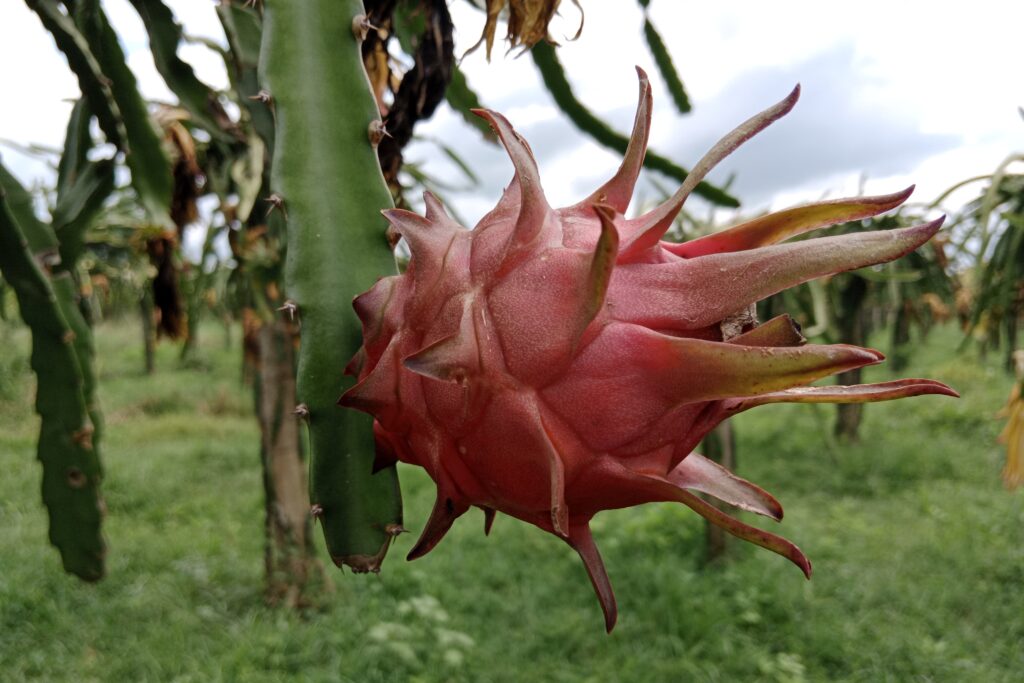Pomelo Farming
Pomelo (Citrus maxima) is the biggest fruit among citrus varieties, featuring a thick peel and a juicy, mildly sweet or slightly sour interior. Originating from Southeast Asia, it is a good source of vitamin C, fiber, and antioxidants. The fruit grows well in tropical and subtropical climates, especially in well-drained soils.
Pomelo is commonly eaten fresh, added to salads, or processed into juices and preserves. With its long storage life, good market demand, and relatively low maintenance needs, pomelo is gaining popularity as a profitable fruit crop for commercial cultivation.
Pomelo farming can be a highly profitable long-term investment, with an estimated total net profit of NRs. 4,224,600 per acre over a 30-year period—equivalent to an average annual return of NRs. 140,820. The pomelo farming profit per acre becomes positive from Year 5, with full cost recovery achieved by Year 9. Early years show cumulative losses reaching NRs. –226,600 by Year 4, but steady gains in the following years turn the balance positive, hitting NRs. 145,000 by Year 9.
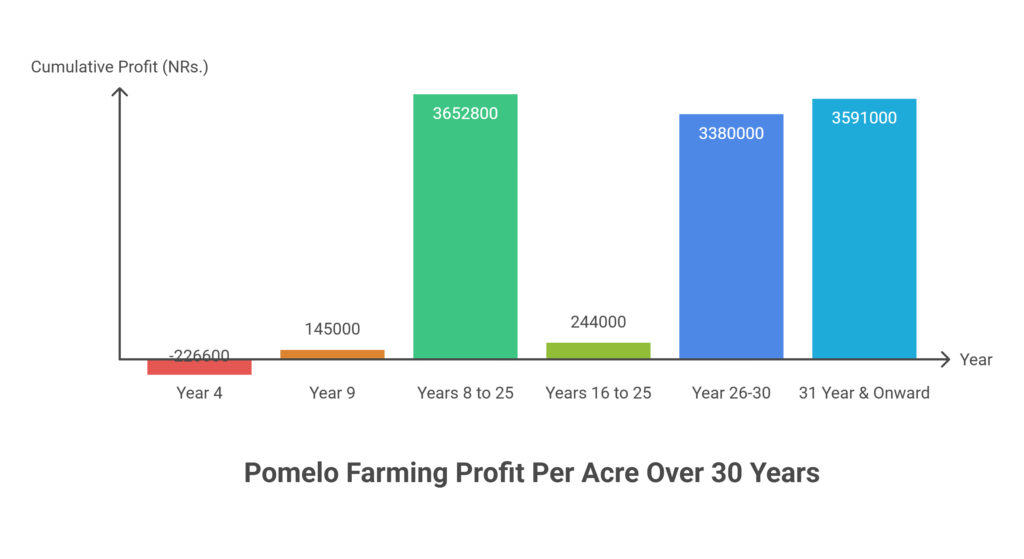
The most lucrative period spans Years 8 to 25, contributing 86.5% of the total profit (NRs. 3,652,800), with peak annual profits of NRs. 244,000 during Years 16 to 25. Even under variable conditions, pomelo farming remains resilient—where a 20% rise in costs reduces profit to NRs. 3,380,000, and a 15% market price drop lowers it to NRs. 3,591,000.
Land Preparation
Land preparation involves several key steps to ensure optimal conditions for planting. It begins with clearing the land by removing existing vegetation such as trees, stumps, bushes, and weeds. This is followed by deep plowing to a depth of 18–24 inches using a moldboard plow or subsoiler to break hardpans, enhance soil aeration, and support deep root growth.
Harrowing is then carried out to break down large soil clods and level the field, creating a smooth surface for planting. Finally, basins are constructed around planting spots, or drainage ditches are installed along contours to manage water runoff and prevent waterlogging, particularly in areas with heavy rainfall or flat terrain
Soil Type
Pomelos thrive best in deep (at least 3–4 feet), well-drained loamy or sandy loam soils rich in organic matter, with a slightly acidic to neutral pH range of 5.5 to 7.0. If the soil is too acidic or alkaline, corrective measures like liming or applying sulfur/gypsum should be taken. Good drainage is crucial, as pomelo roots are highly prone to rot caused by Phytophthora in poorly drained, heavy clay, or waterlogged soils. Saline soils should also be strictly avoided to ensure healthy growth and productivity.
Climatic Requirements
Pomelos thrive in warm subtropical or tropical climates, preferring temperatures of 25°C to 30°C (77°F to 86°F). While they can endure brief dips to -3°C (27°F), frost damages young growth and fruit. Conversely, temperatures exceeding 38°C (100°F) during flowering or fruit set lead to fruit drop.
Although ideally receiving 1500-2500 mm (60-100 inches) of well-distributed annual rainfall, irrigation becomes essential in dry periods, particularly during flowering and fruit development. Moderate to high humidity is beneficial, and full sun exposure (6-8 hours daily) is crucial for healthy growth and fruit sweetness. Windbreaks are necessary to shield trees from damaging winds that cause stress, fruit scarring, and drop.
Major Cultivars
Major pomelo cultivars should be selected based on their adaptability to the local climate, market preferences such as flesh color (white, pink, or red), sweetness or acidity levels, seedlessness, resistance to diseases, and overall yield potential. For best results, it is recommended to use grafted plants sourced from certified nurseries.
Seedling Rate per Acre
Pomelos are typically propagated vegetatively through budding or grafting onto suitable rootstocks to ensure true-to-type fruit production, enhance disease resistance, and promote early fruiting. For commercial cultivation, the standard seedling requirement is approximate 112 grafted saplings per acre,
Planting
Planting Season
The ideal time for planting pomelos is from June to September. Best time to plant is the onset of the rainy season in tropical regions. This timing ensures adequate soil moisture and water availability, promoting successful establishment and early growth of the saplings.
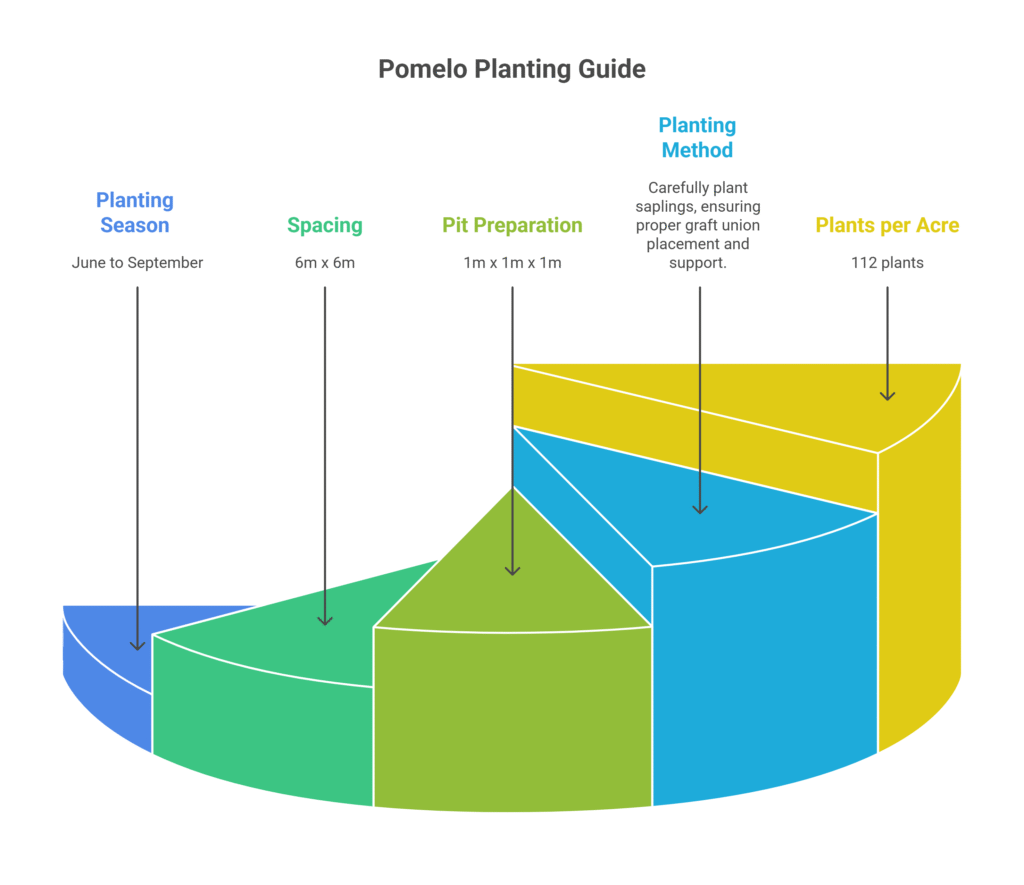
Spacing
For pomelo cultivation, a common spacing recommendation for moderately vigorous varieties in average soil conditions is 6 meters × 6 meters. This allows for proper canopy development, air circulation, and ease of orchard management such as pruning, irrigation, and harvesting
Pit Preparation
Pit Preparation: To allow for soil settling and microbiological activity, prepare planting pits at least three to four weeks prior to planting. Every pit ought to be 1 m by 1 m by 1 m.
If nematodes or Phytophthora are known to be a danger, fill the pits with a mixture of topsoil, 30–50 kg of well-rotted farmyard manure (FYM) or compost, 1–2 kg of bone meal or single super phosphate (SSP), 100g of Trichoderma viride, and 100–200g of a soil-applied nematicide or fungicide. To allow for settling over time, the filled hole should be raised just a little bit above the ground.
Planting Method
Begin by making a small hole in the center of the prepared pit. Carefully remove the polybag or graft union tape without disturbing the root ball, and place the plant into the hole, ensuring the graft union is positioned at least 6–8 inches above the soil level to prevent scion rooting and reduce disease risk.
Backfill with soil, gently firming around the roots to eliminate air pockets. Form a small basin around the plant for efficient watering, then water thoroughly immediately after planting. Finally, provide a sturdy stake to support the plant against wind damage.
Number of Plants per Acre
For pomelo cultivation, a total of 112 grafted plants per acre is recommended
Intercropping
Intercropping in pomelo orchards during the first 3–4 years helps generate early income, optimize land use, and suppress weeds. Suitable intercrops include short-duration, shallow-rooted, and non-competitive crops such as legumes (beans, peas, groundnut), vegetables (cabbage, tomato, onion, radish), pineapple, or flowers.
Avoid tall crops like maize or sugarcane, climbers, and other citrus species. Intercrops should be planted at least 1–1.5 meters away from the pomelo trunk, with separate application of fertilizers or manure. Intercropping should be discontinued once the pomelo canopy covers more than 50% of the area.
Irrigation
Adequate irrigation plays a vital role in successful pomelo cultivation, particularly during critical stages such as the first year of establishment, flowering, fruit set, and fruit development, as insufficient water during these times can result in flower and fruit drop as well as poor fruit quality.
Young plants should be irrigated every 3–5 days, while mature trees typically need watering every 7–15 days during dry spells. Deep and less frequent irrigation is more beneficial than shallow, frequent watering. Preferred methods include drip systems, basin irrigation, and micro-sprinklers, while overhead sprinklers should be avoided to reduce the risk of foliar diseases.
During winter or dormancy, irrigation should be minimized to encourage flowering, and watering should be stopped 1–2 weeks before harvest to improve fruit sweetness, rind texture, and reduce splitting.
Fertilizer and Manure
| Tree Stage | Fertilizer Type | Dosage & Frequency |
| Young Trees (Years 1–3) | Nitrogen (N) | 100–200 g/tree/year, split into 4 applications (every 3 months) |
| Phosphorus (P₂O₅) | 50 g/tree/year (proportionate to N) | |
| Potassium (K₂O) | 50g/tree/year (proportionate to N) | |
| FYM/Compost | 10–20 kg/tree/year | |
| Focus | Promote vegetative growth | |
| Bearing Trees (Year 4+) | FYM/Compost | 25–50 kg/tree/year |
| Nitrogen (N) | 500–800 g/tree/year | |
| Phosphorus (P₂O₅) | 250–400 g/tree/year | |
| Potassium (K₂O) | 500–800 g/tree/year | |
| Split Application | 1st Dose (Post-Harvest/Pre-Spring Flush) | 30–40% of NPK + Full FYM |
| 2nd Dose (After Fruit Set) | 30–40% of NPK | |
| 3rd Dose (During Fruit Development) | 20–30% of NPK (focus on Potassium) |
Application Method
Fertilizers should be applied by spreading them evenly within the drip line or canopy spread of the tree, lightly incorporating them into the soil to ensure good contact, and then irrigating the area to help nutrients penetrate and become available to the roots.
Weed Control
Weed control in pomelo orchards is crucial for healthy tree growth and can be managed using multiple approaches. Mulching is highly recommended; applying an 8–12 cm thick layer of organic mulch such as paddy straw, dried grass, compost, or coir pith around the tree base helps suppress weeds, conserve soil moisture, regulate temperature, and improve soil health. Make sure to leave a small gap near the trunk and replenish the mulch annually.
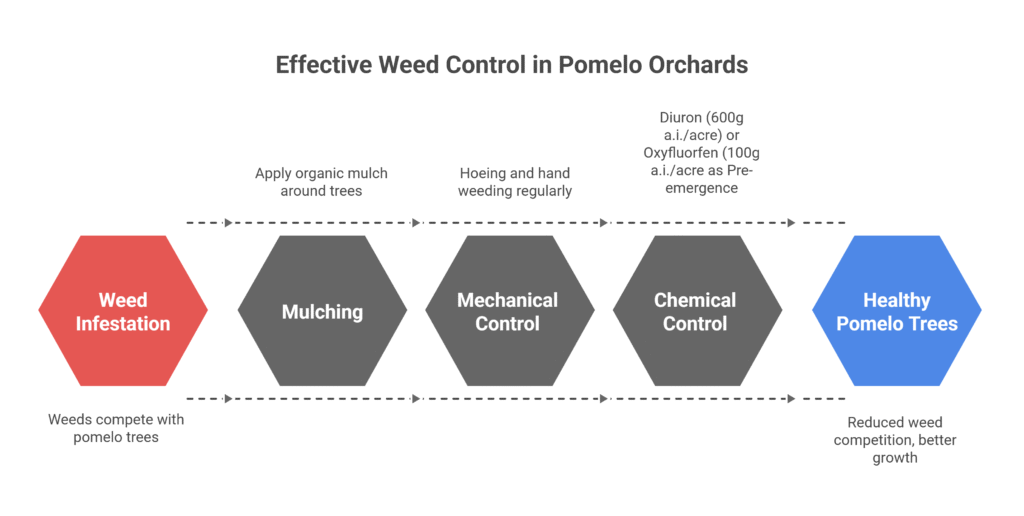
Mechanical control involves regular hoeing or hand weeding within the basin area—about 1 to 2 meters in diameter—and between the rows. It’s important to maintain a weed-free zone especially around young trees to reduce competition for nutrients and water.
Chemical weed management should be approached carefully and used only when truly required. For pre-emergence control, herbicides such as Diuron (600g a.i./acre) or Oxyfluorfen (100g a.i./acre) are effective in preventing weed seed germination. For post-emergence control, Glyphosate can be applied at 500 ml per acre, but it must be used with extreme caution to avoid any contact with the tree trunk or foliage, as it can cause significant plant injury. These chemicals are generally applied in the inter-row areas, while tree basins are better managed using organic mulch. Always adhere strictly to the product label and safety guidelines to ensure both efficiency and environmental safety.
Interculture Operation (Training and Pruning)
Training (Young Trees)
The goal of training young pomelo trees is to establish a strong and balanced framework by selecting 3–4 well-spaced primary scaffold branches, ideally 18–24 inches above ground level. Suckers emerging below the graft union should be removed promptly. Pruning during this stage should encourage outward growth to form a broad, open canopy structure that supports future productivity and ease of management.
Pruning (Bearing Trees)
In mature, fruiting pomelo trees, pruning is carried out to maintain an open canopy that enhances sunlight exposure and air movement. It also helps remove dead, diseased, or damaged branches, manage tree height, and get rid of water sprouts, suckers, and densely packed limbs. The best time to prune is immediately after harvest and before the onset of the spring growth flush.
Always use clean, sharp tools to make accurate cuts close to the branch collar, and target branches that grow inward, cross over others, or hang downward. Avoid heavy pruning, as it can reduce fruit production. A routine of light pruning each year is usually adequate, while more intensive corrective pruning should be done only when necessary.
Flowering and Fruit Management
Flowering
In pomelo cultivation, flowering is influenced by environmental conditions. In subtropical regions, it is typically induced by cool, dry weather, while in tropical areas, controlled water stress can stimulate blooming. The main flowering season usually occurs during spring.
Fruit Set
Pomelo trees generally undergo natural pollination; however, many varieties are parthenocarpic and can set seedless fruits without pollination. Increased bee activity can lead to cross-pollination, resulting in a higher proportion of seeded fruits.
Fruit Thinning
Thinning is an essential management practice performed 4–8 weeks after fruit set, when the fruits are about marble to golf ball size. It helps prevent limb breakage and improves overall fruit quality—enhancing size, sweetness, and color—and ensures more consistent annual yields.
Thinning Method
Start by removing any misshapen, diseased, or damaged fruits. Then, selectively thin smaller fruits, retaining 1–3 of the healthiest and largest fruits per fruiting spur. Fruits should be spaced 6–10 inches apart and preferably kept on the outer part of the canopy for better development.
Pest and Disease Management
Common Pests
Citrus Psyllid
The most dangerous disease affecting citrus crops, Huanglongbing (HLB or citrus greening), is spread by the citrus psyllid, making it a significant pest. Effective management requires ongoing monitoring and early discovery. During active pest periods, systemic insecticides like Imidacloprid (0.3–0.5 ml per liter of water) or Dinotefuran (1–1.5 g per liter) are used as control methods.
Using biological techniques, such as releasing the parasitic wasp Tamarixia radiata, in addition to chemical management can help naturally suppress psyllid populations and lessen the need for pesticides.
Leaf miner
Leaf miners are pests that create winding tunnels in young, tender leaves, leading to reduced photosynthetic capacity and stunted growth in citrus trees. They are particularly active during new flushes, making timing critical for effective control. Management involves spraying insecticides such as Abamectin at 0.3–0.4 ml per liter of water or Spinetoram at 0.25 ml per liter, applied during the early stages of leaf flushing when larvae are actively feeding. Systemic insecticides can also be used for longer-lasting protection. Regular monitoring and timely intervention help minimize damage and support healthy canopy development.
Scale Insects/Mealybugs
These sap-sucking pests erode citrus trees by consuming plant fluids and secreting honeydew, which inhibits photosynthesis and encourages the formation of sooty mold. Use of insecticidal soaps or horticultural oils (1.5–2% solution) that smother the pests upon contact are examples of effective control. Systemic insecticides, such as imidacloprid (0.3–0.5 ml per liter of water), can be used for longer-lasting control in cases of severe infestation. Additionally, it is critical to preserve natural adversaries like parasitic wasps and lady beetles, which help control pest numbers and lessen the need for frequent chemical treatments.
Fruit Flies
Fruit flies are a serious hazard to citrus production because they lay their eggs just under the fruit’s skin, which can result in internal damage and early fruit drop. A variety of tactics are needed for effective management, such as the use of bait stations that combine pesticides like Spinosad (0.5–1.0 ml per liter of water) with protein-based attractants to attract and kill adult flies. Pheromone traps and male annihilation methods aid in lowering the breeding population. Crop losses are reduced and the fruit fly lifecycle is further disrupted by maintaining proper field sanitation through routinely picking fallen and contaminated fruits and making sure harvesting occurs on time.
Aphids/Mites
These pests can seriously harm plants by consuming young leaves and shoots, which can result in stunted development and diminished plant vitality. Frequent surveillance is necessary to identify growing populations early. When infestations become out of control, treatment options include using horticultural oils (1.5–2% solution) or insecticidal soaps (1-2%) to control aphids, and utilizing miticides like Abamectin (0.3–0.4 ml per liter) to suppress mite populations. By applying these remedies on time, beneficial insects are less harmed and the trees are protected.
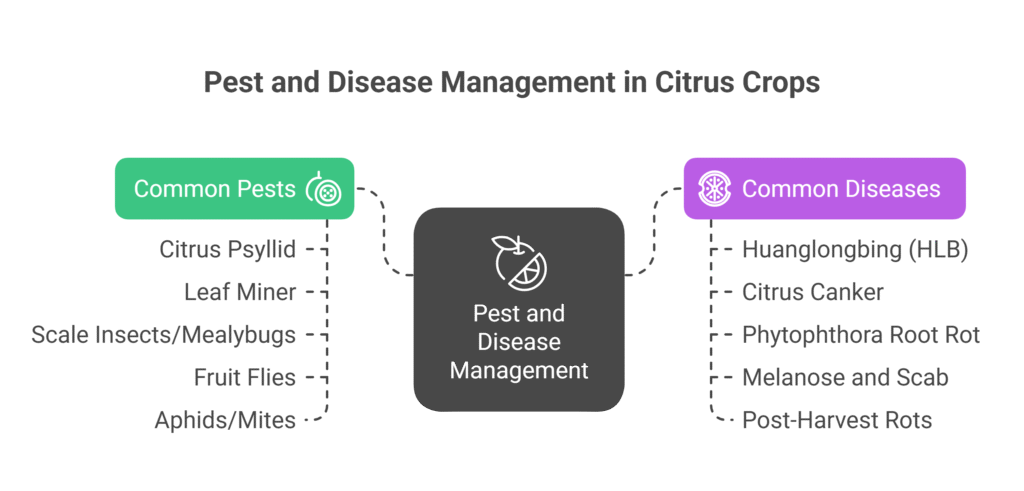
Common Diseases
Huanglongbing (HLB/Citrus Greening)
The citrus psyllid is the vector for the deadly bacterial disease known as HLB. Since there is currently no treatment for infected trees, management focuses on removing and destroying infected trees as soon as possible, using systemic insecticides like Imidacloprid (0.3–0.5 ml per liter of water) or Dinotefuran (1–1.5 g per liter), and making sure that disease-free planting material is used to stop the spread of the disease.
Citrus Canker
This bacterial disease causes characteristic lesions on leaves, stems, and fruits, leading to premature fruit drop and reduced quality. Control involves strict quarantine measures and sanitation, establishing windbreaks to reduce spread, and applying copper-based bactericidal sprays such as Copper Oxychloride or Copper Hydroxide at 2.5–3.5 g per liter, sprayed every 10–14 days during wet conditions and susceptible growth stages. Infected leaves and fruits should be removed and destroyed to limit inoculum sources.
Phytophthora Root Rot/Gummosis
A fungal disease favored by poorly drained, wet soils, it causes root decay and gum exudation from the trunk. Prevention is critical—ensure excellent soil drainage, plant trees on raised beds, and avoid wetting the trunk during irrigation. For chemical control, use fungicide drenches with systemic fungicides such as Fosetyl-Al (2.5–3 g per liter) or Metalaxyl (2–3 g per liter) applied as soil drenches around the root zone every 2–3 months during wet seasons to suppress pathogen activity.
Melanose and Scab
These fungal diseases primarily affect fruit rind appearance, causing blemishes that reduce marketability. Apply copper fungicides like Copper Oxychloride (2.5–3 g per liter) starting at petal fall and continuing at 10–14 day intervals through early fruit development to protect young tissues from infection.
Post-Harvest Rots (Penicillium, Diplodia)
Post-harvest fungal infections cause fruit decay during storage and transport. Maintain proper orchard sanitation and handle fruit carefully to minimize injury. When necessary, use fungicide dips such as Imazalil (250 ppm) or Thiabendazole (1000 ppm) for harvested fruit to reduce rot incidence during storage and shipment.
Harvesting
Maturity Indices
A number of ripeness indications must be carefully evaluated before pomelos are harvested. These include a smooth rind texture, a fruit that feels hefty for its size, and the color break, where the rind turns from green to yellowish-green or yellow depending on the cultivar. Chemical tests such as Total Soluble Solids (TSS) greater than 8–10° Brix and a TSS to acid ratio above 8:1 are also significant, as is a minor softening at the blossom end. Instead of depending solely on color, it’s crucial to employ a mix of these cues.
Timing
The harvest period typically occurs 6 to 9 months after flowering, varying with the cultivar and climatic conditions. The main harvesting season usually falls between late autumn and early spring.
Harvesting Method
Harvesting fruits should be done with sharp shears or clippers, cutting the stem between 1/4 and 1/2 inch above the fruit button or calyx. Fruit should not be pulled or twisted off because this destroys the stem end and speeds up deterioration. Fruits should be handled carefully to avoid rind damage and bruises.
Harvest Frequency
Harvesting should be done in several rounds to choose fruits when they reach their ideal maturity because fruits ripen at different periods.
Yield
Yield varies with the age of the tree. During the early productive years (3–5 years), young trees typically produce about 10 to 30 fruits per tree, equating to approximately 5 to 15 kg per tree. As the trees mature (from year 8 onward), the yield significantly increases, with an average of around 25,200 kg per acre, or approximately 25 metric tons per acre.
Cost of Investment per Acre for Pomelo Farming
| S.N. | Categories | Cost (NRs.) |
| 1 | Land Preparation (plowing) | 15,000 |
| 2 | Plant saplings | 28,000 |
| 3 | Pit digging | 7,000 |
| 4 | Planting | 5,000 |
| 5 | Fertilizers and Manure | 30,000 |
| 6 | Irrigation | 20,000 |
| 7 | Weed Control (pre & post-emergence) | 5,000 |
| 8 | Pest & Disease Control | 7,000 |
| 9 | Miscellaneous Costs | 10,000 |
| Total Initial Investment | 127,000 |
Annual maintenance cost per acre
From the second year onward, pomelo farming requires an annual maintenance cost of approximately NRs. 50,000 per acre, covering expenses such as fertilizer application, irrigation, pest and disease control, weeding, and general upkeep to sustain tree health and productivity.
Income per acre from Pomelo Farming
| Year(s) | Yield/Tree (kg) | Yield/Acre (kg) | Price (NRs/kg) | Income/Acre (NRs) |
| 3 | 5 | 560 | 30 | 16,800 |
| 4 | 10 | 1,120 | 30 | 33,600 |
| 5 | 15 | 1,680 | 30 | 50,400 |
| 6-7 | 25 | 2,800 | 30 | 84,000 |
| 8-15 | 60 | 6,720 | 30 | 201,600 |
| 16-25 | 75 | 8,400 | 35 | 294,000 |
| 26-30 | 50 | 5,600 | 35 | 196,000 |
| 31+ | 25 | 2,800 | 40 | 112,000 |
Analysis of Pomelo Farming Profit Per Acre
| Phase (Years) | Years | Cost/Year (NRs) | Income/Year (NRs) | Net Profit/Year (NRs) | Total Net Profit (NRs) |
| Year 1 | 1 | 127,000 | 0 | -127,000 | -127,000 |
| Year 2 | 1 | 50,000 | 0 | -50,000 | -50,000 |
| Year 3 | 1 | 50,000 | 16,800 | -33,200 | -33,200 |
| Year 4 | 1 | 50,000 | 33,600 | -16,400 | -16,400 |
| Year 5 | 1 | 50,000 | 50,400 | 400 | 400 |
| Years 6-7 | 2 | 50,000 | 84,000 | 34,000 | 68,000 |
| Years 8-15 | 8 | 50,000 | 201,600 | 151,600 | 1,212,800 |
| Years 16-25 | 10 | 50,000 | 294,000 | 244,000 | 2,440,000 |
| Years 26-30 | 5 | 50,000 | 196,000 | 146,000 | 730,000 |
| Total | 30 | – | – | – | 4,224,600 |
Over a 30-year period, pomelo farming yields a total net profit of NRs. 4,224,600 per acre, averaging NRs. 140,820 per year. The payback period ends by Year 9, with positive cash flow beginning modestly in Year 5 (NRs. 400). Initial cumulative losses peak at NRs. –226,600 in Year 4, then gradually recover, turning positive in Year 9 with NRs. 145,000. The high-profit phase spans Years 8–25, contributing NRs. 3,652,800—or 86.5% of the total profit—with peak earnings of NRs. 244,000 annually during Years 16–25. Sensitivity analysis shows that a 20% increase in costs reduces profit to NRs. 3,380,000, while a 15% drop in market price lowers it to NRs. 3,591,000.
Sources
Food and Agriculture Organization (FAO)
University of California Agriculture & Natural Resources (UC ANR)
Nepal Agricultural Research Council (NARC)
Punjab Agricultural University (PAU)
Tamil Nadu Agriculture University (TNAU) – Agritech portal
Indian Council of Agricultural Research (ICAR)

